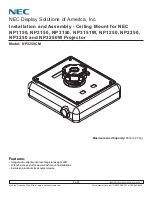
15
Positioning your projector
English
Obtaining a preferred projected picture size
The distance from the projector lens to the screen, the zoom setting, and the video format each factors in the
projected image size. BenQ has provided separate tables of dimensions for both 16:9 and 4:3 screen ratios to
assist you in determining the ideal location for your projector.
The projector should always be placed horizontally level (like flat on a table), and positioned directly
perpendicular (90° right-angle square) to the horizontal center of the screen. This prevents image distortion
caused by angled projections (or projecting onto angled surfaces).
If the projector is mounted on a ceiling, it must be mounted upside-down so that it projects at a slightly
downward angle.
This projector is equipped with a movable lens. See
"Shifting the projection lens" on page 18
for details.
BenQ has provided tables of 16:9-aspect-ratio and 4:3-aspect-ratio screen sizes to assist you in determining the
ideal location for your projector. The vertical offset heights in the dimension tables on page
16
and
17
are
measured when the lens is shifted fully up or down. You can see from the diagrams on page
16
and
17
, that this
type of projection causes the bottom edge of the projected image to be vertically offset from the horizontal
plane of the projector. When ceiling mounted, this refers to the top edge of the projected image.
There are two dimensions to consider, the perpendicular horizontal distance from the center of the screen
(projection distance), and the vertical offset height of the projector from the horizontal edge of the screen
(offset).
If the projector is positioned further away from the screen, the projected image size increases, and the vertical
offset also increases proportionately.
When determining the position of the screen and projector, you will need to account for both the projected
image size and the vertical offset dimension, which are directly proportional to the projection distance.
How to determine the position of the projector for a given screen size
1. Determine the aspect ratio of your screen, 16:9 or 4:3?
2. Refer to the table and find the closest match to your screen size in the left columns labelled
"Screen
Dimensions"
. Using this value, look across this row to the right to find the corresponding average distance
from screen value in the column labelled "Average". This is the projection distance.
For example, if you are using a 120-inch, 4:3-aspect-ratio screen, please refer to
"4:3 (standard) ratio screen
dimension table"
. The average projection distance is 5332 mm.
If you place the projector in a different position (to that recommended), you will have to tilt it down or up to
center the image on the screen. In these situations, some image distortion will occur. Use the Keystone function
to correct the distortion. See
"Adjusting the projected image" on page 26
for details.
How to determine the recommended screen size for a given distance
This method can be used for situations where you have purchased this projector and would like to know what
screen size will fit in your room.
The maximum screen size is limited by the physical space available in your room.
1. Determine the aspect ratio of your screen, 16:9 or 4:3?
2. Measure the distance between the projector and where you want to position the screen. This is the projection
distance.
3. Refer to the table and find the closest match to your measurement in the average distance from screen
column labelled "Average". Check that your measured distance is between the min and max distances listed
on either side of the average distance value.
4. Using this value, look across that row to the left to find the corresponding screen diagonal listed in that row.
That is the projected image size of the projector at that projection distance.
For example, if you have a 16:9-aspect-ratio screen and your measured projection distance was 4.5m
(4500mm), please refer to
"16:9 (widescreen) ratio screen dimension table"
. The closest match in the "Average"
















































